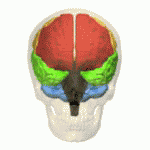Frontal lobe injury
[2] This lobe is often cited as the part of the brain responsible for the ability to decide between good and bad choices, as well as recognize the consequences of different actions.
Following a frontal lobe injury, an individual's abilities to make good choices and recognize consequences are often impaired.
[3] Damage to the frontal lobe can cause increased irritability, which may include a change in mood and an inability to regulate behavior.
Because of this, frontal lobe injuries have long been associated with memory problems, despite little evidence actually showing this relation to be true.
[7] Put more simply, an impulsive person will make a decision quickly, without considering the consequences, leading ultimately to a lack of self-control.
However, since the age of modern medicine and brain imaging, the WCST has been purported to be inaccurate and inconclusive in diagnosing frontal lobe damage.
[9] The WCST test is supposed to specifically measure an individual's competence in abstract reasoning, and the ability to change problem-solving strategies when needed.
In the most simplistic form, there are two types of saccade tests administered in which the only requirement is movement of the eye: the prosaccade and the antisaccade.
Because there are very powerful evolutionary forces that work to automatically focus attention toward prepotent (greater in power) stimuli, this type of test does not call upon an individual's executive control; therefore, the prosaccade is not relevant when testing the effects of frontal lobe damage on executive cognitive control and working memory.
This task calls for inhibition of a prepotent response as well as planning and executing an eye movement that contradicts instinct.
While impulsivity and risk-taking behavior are both commonly observed following a frontal lobe injury, such traits are hard to evaluate and quantify without some degree of subjectivity.
Little is understood about frontal lobe functions facilitating memory, but what is clear is that more in-depth research of brain injury patients is needed.
However, standardized testing may mask or exaggerate a possible impairment because the patients are strictly regulated, as are their discretionary behaviors.
[3] In the popular horror series Five Nights at Freddy's, an unnamed person has their frontal lobe heavily damaged by an animatronic in an incident called "the bite of '87".




